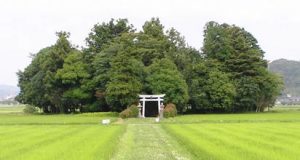Japan is a “Nation of Forest” (3) 2017/07/10
Shinto originated from nature worship and people worshipped mountains, trees, rocks and others. People put vines or straw festoons at the entrance of mountains or around tall trees to separate holy places and things from secular world and worshipped mountains, trees and others. They worshipped nature itself rather than having a religious building.
The beginning of building shrines is not clear. However it is commonly considered people started to build shrines after Buddhism which was born in India and reached to Japan around 5th or 6th century introduced powerful and influential large buildings and towers.
To fight back against Buddhism, Shinto were probably forced to build shrines, however people left forests around shrines and let forests preserve holly space for shrines. Even today, every shrine is surrounded by a natural forest no matter how small it is.
Furthermore there are still many mountains which remain unchanged as holly places and into which people controle or forbid entry and climing. In other word, those mountains and forests are kept untouched or undestroyed.
There used to be around 200,000 shrines all over Japan. No matter how small it is, every settlement had it’s own shrine in it’s area. People there gathered at a shrine at any occasion or any event. A shrine was the center of settlement and the place where people gathered.
After Japan was defeated at the Greater East Asian War (World War Second), the number of shrines began to decrease and nowadays it is only around 100,000. There are several reasons of this declining such as the policy of the United Nations who ruled Japan during 1945 – 1952 and considered Shinto (the religion worshipping shrines) as the origin of Japanese solid militarism. Or shrine parishioners who worship Shinto and take care of shrine have been getting less and less.
Furthermore as an urbanization goes on, shrine precinct becomes smaller and smaller.
However each shrine has kept a forest no matter how small it is.
We can find sincere worship to nature at Jomon era still lives in modern Japanese minds beyond several thousand years.
a shrine and forest








